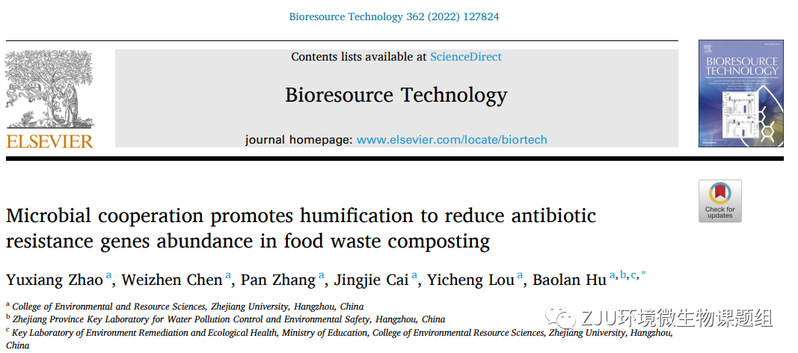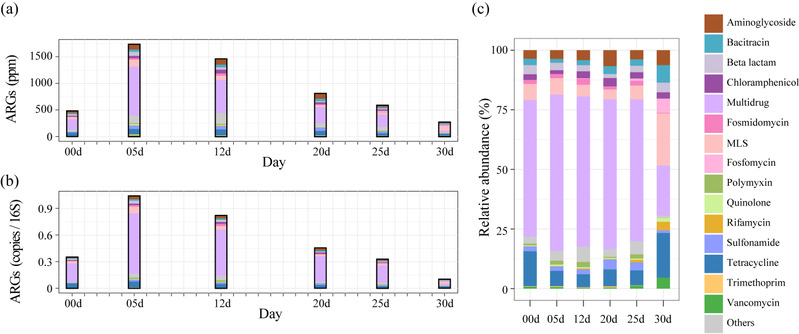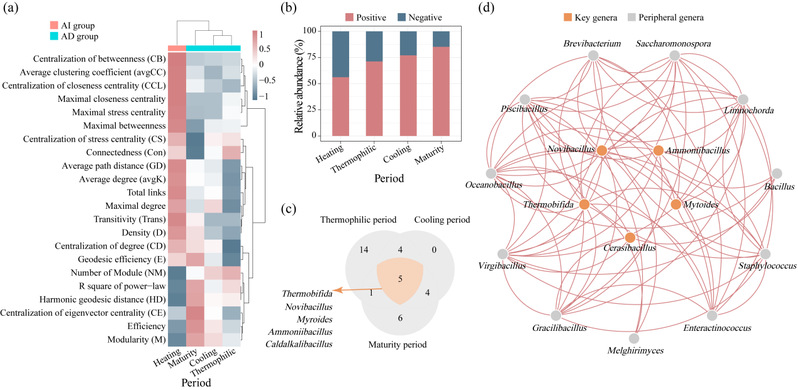Professor Hu Baolan's team published a paper in Biosource Technology, revealing that microbial cooperation to promote humification can reduce the abundance of antibiotic resistance genes in food waste compost
2023-03-17
First author: Zhao Yuxiang
Corresponding author: Hu Baolan
Communication unit: Zhejiang University
In recent years, the abuse of antibiotics first induced the generation of antibiotic resistance genes (ARGs) in animals, thus accelerating the spread and diffusion of antibiotic resistance genes among bacteria in the environment. At present, as a new type of environmental pollutants, the spread and diffusion of antibiotic resistance genes in different environmental media may be more harmful to the environment than the antibiotic itself.
On October 2, 2022, the team of Hu Baolan from the School of Environment and Capital of Zhejiang University published a research paper online in Biosource Technology entitled Microbial cooperation promotes humidification to reduce antibiotic resistance genes resistance in food waste composting to conduct a comprehensive study on the changes of antibiotic resistance genes (ARGs) in food waste composting. The research results show that the change of ARGs over time is caused by the competition and cooperative transformation between microorganisms. Further analysis shows that the competition of microorganisms may increase the abundance of ARGs. SEM analysis shows that humification index (GI) can be used to characterize the relationship between microbial interaction and ARGs, for example, mature compost (GI>92.6%) can reduce the risk of ARGs flow.

First of all, 412 ARGs related to 22 antibiotics were identified in this study, and their abundance fluctuated between 169.7 and 1739.2 ppm at different stages of composting, showing an obvious trend of increasing first and then decreasing (Figure 1). ARGs related to multi-drug efflux pumps are dominant, with an average abundance of 54.9% (Figure. 1c). The second is ARG related to tetracycline (9.8%), macrolides (8.4%), aminoglycosides (4.7%) and bacitracin (3.3%). In addition, the detection frequency of these ARGs types in all periods is 100%. In detail, on days 0, 5, 12, 20 and 25, the ARGs related to the multi-drug efflux pump accounted for 57.4% - 65.6%, which were the main ARGs in these periods.

Figure 1. ARGs detection profile of compost samples. a: Abundance of ARGs (ppm); b: Abundance of ARGs (copies/16S copies); c: Abundance ratio of ARGs type
In addition, in order to explore the potential interaction and succession process of microbial communities, the author constructed a generic level network diagram (Figure 2) of different periods. According to the network diagram analysis, it can be divided into two groups, namely ARGs increase group (AI) and ARGs decrease group (AD). The ARGs abundance of AI mainly increased during the composting heating period, while the ARGs abundance of AD continued to decrease during the composting high temperature period, cooling period and maturity period, and the network complexity of AI group was more than 1.8 times that of AD group (Figure 2. a). This result suggests that cooperation between microorganisms may be one of the key factors to reduce ARGs. Further, this study also identified key genera that may have potential interactions with other microorganisms.

Figure 2. Potential microbial interactions at different composting stages. a: Cluster heat map of AI group and AD group; b: Correlation analysis; c: Key bacteria of AD group; d: Relationship between key genera and other genera
At the same time, the study further explored the relationship between microbial interaction, humification and ARGs abundance, and the results showed that microbial cooperation might reduce ARGs abundance by enhancing humification. Further, this study collected online data to prove the correlation between humification and ARGs. The results showed that the germination rate of seeds representing humification index was significantly negatively correlated with the absolute and relative contents of ARGs. After composting, the abundance and risk of resistance genes in kitchen waste are lower than the local value of soil, indicating that composting can effectively reduce the risk of ARGs in kitchen waste.
The results showed that the abundance and diversity of ARGs increased first and then decreased. During the increase of ARGs, intensive microbial antagonism can be observed. At the same time, in the period of ARGs reduction, cooperation reached its peak. Therefore, the conversion between competition and cooperation may be the reason for the change of ARGs during FW composting. In addition, the key bacteria affecting microbial cooperation are highly correlated with those related to humification, and the humification index is significantly negatively correlated with the abundance of ARGs.
This study revealed that microbial cooperation can strengthen the humification process and reduce the ARGs abundance. It provides a new theoretical basis and solution for effectively controlling the spread and diffusion of antibiotic resistance genes in the environment and causing ecological risks.
